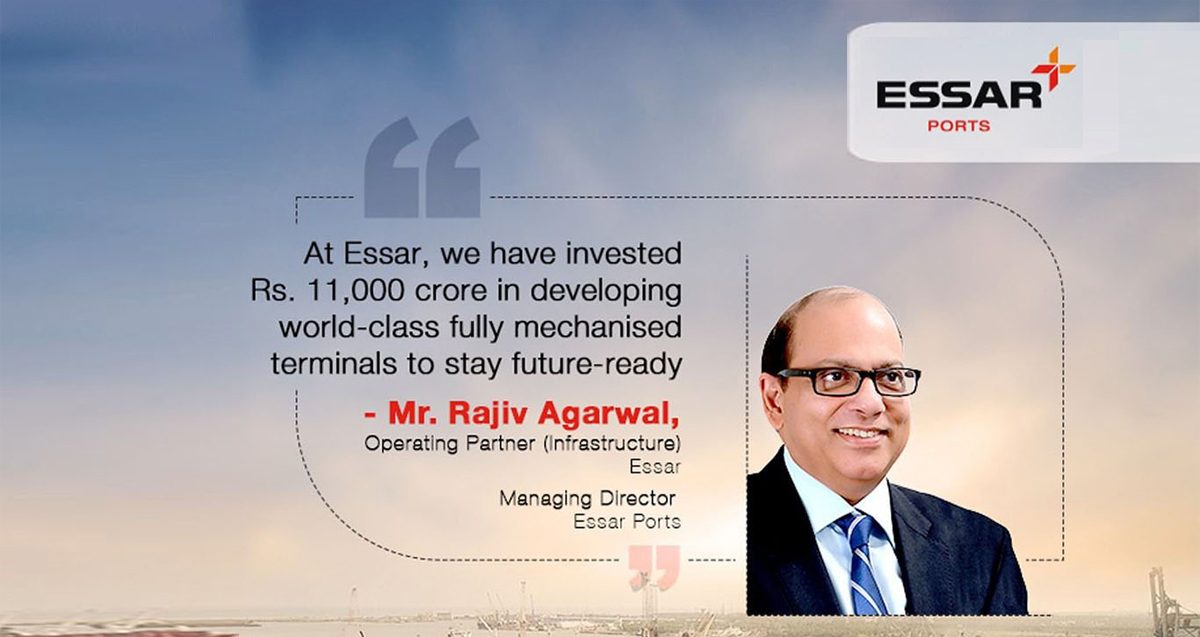Mr Rajiv Agarwal, Operating Partner (Infrastructure), Essar and MD, Essar Ports in an interview with Equipment Times magazine.
Below are excerpts from the interview.
How do you see the port-led development giving a boost to cargo movement and India becoming a transit cargo hub?
India’s port sector has great potential to contribute to the country’s overall economic growth. Our Government is taking necessary steps to modernise ocean gateways along with the port operators and industry stakeholders, keeping in mind the key issues pertaining to logistics infrastructure and commerce.
The Sagarmala Programme aims to reduce logistics cost, boost trade and industrial growth by easing traffic congestion. The project will increase productivity in the country by creating an efficient transportation infrastructure with minimal investment. The initiative paves way to structural and sustainable growth in India with a focus on Ports. This will open up a plethora of opportunities, be it Brownfield or Greenfield.
As India charts its way towards a US$ 5 -Trillion economy and on becoming a global economic powerhouse, there will be pockets of production and consumption centers. This will not only enhance trade flow but also develop new channels. With strong demand coming in from domestic consumption and boost in manufacturing, the country is well positioned to be one of the important manufacturing and trade hubs globally.
Essar Ports is one of the largest private sector port and terminal developers & operators in India by capacity and throughput. It has four operational terminals in India across Hazira (50 MT) and Salaya (20 MT) on the west coast (both in Gujarat), and one each in Visakhapatnam Port (24 MT; Andhra Pradesh) and Paradip Port (16 MT; Odisha) on the east coast. Current operational port terminal capacity in India is 110 MTPA which contributes to roughly 5% of India’s port capacity.
Essar Ports has been aggressively investing in technologies and developing environment-friendly and efficient handling systems. All our terminals have deep draught to accommodate vessels upwards of 100,000 tonnes DWT which are highly mechanised and equipped with the latest cargo handling equipment, thus ensuring most competitive vessel turnaround times in the Indian ports sector. We are well poised to handle over 50 Million Tonnes of cargo the current financial year ensure optimum utilization of infrastructure and room to cater to industry needs.
What are the policy initiatives and measures required by the government to push growth further in the sector?
The Indian government has been providing the much needed support to the Ports and Infrastructure sector with multiple reforms to mitigate the impact caused by the pandemic. The Ministry of Ports, Shipping and Waterways has undertaken various measures and implemented many initiatives to boost the sector and economy.
However the need of the hour for f urther boosting the ports and logistics sector are:
- Supporting existing PPP projects through incentives and addressing their concerns
- Tariff flexibility for old concessions in major ports (under different tariff regimes) is one area, which private terminals are looking at. It will put old concessions in equal footing with new concessions in major ports and non-major ports
- Mechanisms to enable flexibility in long term concessions to ride out the evolving market dynamics and other risks impacting projects and operations
- Enhancing ease of low cost of finance to fund the projects.
Indian ports have a crucial role to play in unleashing our country’s economic potential and transforming it into a US$ 5-trillion economy, especially at a time when India is aiming to become Atmanirbhar.
The logistics sector has an indispensable role to play in nation-building and contributing to the Indian economy. However, there are certain factors which the industry players need to work on to stay ahead of competition, such as increasing operational efficiency through mechanisation, reducing pre berthing delays and improving turnaround time. Technology and digitisation will play a significant role in this. There is also a need to have deeper draft at existing and new ports to accommodate larger vessels. Developing multi-modal evacuation facilities at the existing port terminal facilities, with key focus on a comprehensive Rail/ Road connectivity, is needed as it will reduce congestion considerably.
Some of the challenges that are plaguing the infrastructure/ ports sector include the following:
- Low hinterland connectivity through road and rail for ease of evacuation, thus affecting competitiveness
- Availability of low cost long duration Funds
- Low base cargo and manufacturing industries, which are essential for greenfield projects viability
- Non-equitable risk sharing in PPP projects between Concessionaire and Concessioning authority
- High logistics cost (13% of GDP) in India impacting exports competitiveness
Having said that, with India on the march to become a US$ 5 -Trillion economy, the sector has lot of opportunities and just needs a push which our Govt. is already doing through its proactive policies.
At Essar, we have invested Rs 11,000 crore in developing world-class fully mechanised terminals to stay future-ready. Our mechanised facilities enable seamless flow of information and cargo. Additionally, all our terminals are scalable and come with the necessary infrastructure to enhance the capacity to cater to market requirements. We strongly aim to continue investing in the expansion of our capacity and implementing advanced technology to ensure visibility of cargo, handling cargo in the most efficient and environment friendly manner, and to manage bigger vessels with faster turnaround – paving way for lower logistics cost. Similarly, our innovative solutions, which are embedded in technology, will connect directly to customers through multimodal solutions.
As we grow, we continue to aspire to deliver state-of-the-art solutions by inculcating digital transformation and technology that can further give a sustainable advantage to our customers. Essar Ports will continue to expand in the existing line of business, as well as develop new assets, through identification and investment in right opportunities.
